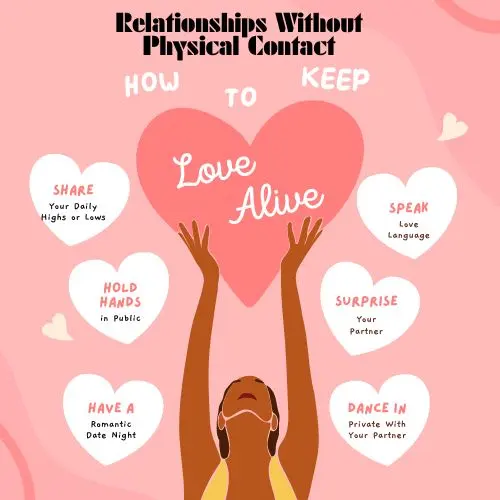Introduction
Love and intimacy can thrive, even across long distances. An estimated 4 to 5 million couples in committed relationships live apart in the United States alone. While physical separation presents undeniable challenges, many couples find creative ways to foster closeness and connection when they can’t physically be together.
Key Facts and Figures on Long-Distance Relationships (LDRs)
| KeyFacts | Figures |
|---|---|
| Number of Couples in LDRs | 4-5 million |
| Average Distances Apart | 125-165 miles |
| Average Length of Separation | 1.5-2.5 years |
| Most Common Reasons for Separation | Work/School, Military Service |
| Methods of Communication | Phone, Video Chat, Text, Email, Letters |
What is a Long-Distance Relationship?

A long-distance relationship refers to an intimate, committed partnership between partners who live far enough apart that they cannot easily see each other every day or week. While definitions vary, long-distance relationships generally involve living at least 50-100 miles apart or being separated by a drive time of at least 2-4 hours.
Long-distance relationship partners have unique challenges compared to geographically close couples, including limited face-to-face interactions, difficulty maintaining emotional intimacy, high communication barriers, and logistical struggles in planning visits. However, many thriving “LDR” couples find creative ways to nurture their bonds across the miles until they can permanently close the gap.
Reasons Partners Choose Long-Distance Relationships

While no couple hopes for or chooses long-distance easily, various life factors can compel committed partners to live apart for months or years:
Work or School Commitments
Demanding jobs, graduate programs away from home, overseas placements, and short-term international assignments commonly separate partners. These career steps can advance long-term goals, even if they temporarily strain relationships.
Military Service
Military families face frequent moves and deployment-related separations spanning months or longer. Modern connectivity helps ease these separations. Despite hardships, many military couples preserve their relationships across deployments and constant relocations.
Cross-Country Moves
When one partner lands a life-changing job opportunity across the country, couples make difficult decisions about who moves, who stays behind, and how to manage living apart until reunited. The economics of job markets also drive separations.
Family Obligations
Cultural expectations or needs to care for children, aging parents, or family back home can tether one partner in place while the other pursues work or school elsewhere. These family barriers lead many couples to live apart.
Visa Restrictions
Immigration laws also impose roadblocks. Couples with one partner on a work, study, or tourist visa may have long waiting periods before they reunify in the same country long-term or permanently.
No matter the reasons driving separation, long-distance partners leverage communication technology, emotional resilience, and creativity to nourish intimacy from afar.
Maintaining Emotional Intimacy From Afar

Long-distance couples often struggle to maintain close emotional connections across the miles, especially as daily stresses and distractions tug attention elsewhere. However, successful LDR partners deploy strategies to continually nurture intimacy despite physical barriers:
Schedule Regular Virtual Dates
Consistently logging quality time together via video chat provides critical face time for separated partners. Setting standing weekly or daily virtual dates protects that priority time ‘together’ when life, work, and time zone differences intervene.
Discuss Hopes, Desires, and Future Plans
Having candid discussions about shared dreams, goals, relationship preferences, and plans beyond the long-distance period helps align couples and provide a shared vision of the future.
Learn Your Partner’s Love Language
Dr. Gary Chapman’s renowned book identifies 5 key “love languages” or expressions of intimacy: physical touch, gifts, acts of service, words of affirmation, and quality time. Discovering which dialects most resonate allows long-distance partners to feel cherished despite the separation.
Write Old-Fashioned Love Letters
Heartfelt handwritten letters deliver that sentimental spark of joy in a relationship. The anticipated ritual of receiving the next romantic or playful post crossed wisps of paper and ink across the distance like nothing else.
Schedule In-Person Reunions
Counting down to the next reunion trip sustains hope during separations and gives partners milestone events to plan for together. Reunification visits allow couples to replenish their physical and emotional intimacy until sustained cohabitation is possible.
Discuss Money-Saving Strategies for Closing the Gap
Partners focused on their long-term future evaluate career options, budget changes, and lifestyle sacrifices to enable ending the long-distance chapter sooner. Brainstorming a target timeline and financial path empowers couples.
By nourishing transparent communication, vulnerability, and constant expressions of affection across the miles, long-distance couples strengthen bonds stretching but not breaking across distance and time.
Unique Communication Strategies for Long-Distance Partners

Separated lovers yearn to share their days, seek support when struggling, and unwrap life’s joyful moments together. Connecting frequently builds emotional bridges across distance. Creative communication strategies that simulate presence help.
Schedule Daily Check-In Calls
Ritual end-of-day or wake-up video calls exchange snippets of wins, stresses, humour or warmth—even quick hellos bridge separations.
Watch Movies or TV Together Virtually
Media streaming apps like Netflix Party, Kast and Teleparty all enable couples to binge series remotely, reminisce over favourite flicks, and enjoy new releases ‘together’ despite the miles through synchronized playback and chatting features.
Video Record Messages
Short phone video clips with cheeky narration bring partners amusingly into little moments – a concert, a pet trick, a recipe mishap, or a sublime sunset.
Forward Funny Memes, Songs and Viral Videos
Shared laughter online bridges divides too. Tagging a long-distance sweetie in clever memes or sending new favourite tunes builds emotional bridges through universal cultural moments despite the distance.
Mail Care Packages
Gift box surprises mailed to a lover’s doorstep inject romantic flair. Photos, baked goods, nostalgic memorabilia, inside jokes that travel – old-fashioned care packages remind sweethearts they are never forgotten.
Frequently reaching across space creatively nurtures bonds so that when partners ultimately reunite, they reconnect seamlessly, with intimacy unbroken.
Navigating Long-Distance Relationship Challenges

No sugarcoating – doing long-distance is tough. The obstacles can fray even solid foundations if partners aren’t radically candid, patient and willing to work cooperatively through hurdles:
Parenting From Afar
When work separates couples with a baby or family at home, parenting remotely through sporadic calls and video chats leaves absent moms and dads longing for critical developmental moments missed. Navigating childcare logistics, medical decisions, and school issues from afar also complicates matters exponentially.
Wrestling with Jealousy and Trust
Humans crave physical togetherness with significant others. Loneliness and jealousy sometimes weave irrational suspicions of fidelity breaches that can corrode formerly sturdy foundations of trust when already distant. Avoiding long separations early in dating for this reason is wise.
Financial Pressures
Frequent travel to visit partners strains budgets between households now shouldering solo costs of rent, utilities and more. Student loan and credit card debt also balloon if using debt to finance reunion trips and multiple households. Couples should budget consciously for relocations ahead.
Major Life Events Missed
Long-unfolding crises like illness and funerals or significant milestones like graduations and weddings all land differently for the partner missing them in real-time. Finding meaningful ways to console and celebrate from afar eases resulting hurt when outside circumstances prohibit being physically present.
Resentment Creeping In
Over long periods apart, separated partners may grow resentful of perceived imbalances in career sacrifices or life ambitions subordinate to the other’s goals. Couples managing disparate career stages well communicate values often; listening generously defuses tension.
Despite the turmoil, couples are determined to weather long-distance life’s storms and actively nurture their connections in anticipation of that long-awaited final reunion.
Looking to the Future: Coping Until Reunification

For long-distance couples focused on their endgame, several strategies ease present-moment frustrations and sustain optimism for when they close the gap permanently at last.
Set a Date!
Having an end date circled on the calendar with a specific plan behind it frames separation as a finite season to weather as partners, not an indefinite phase. Fixed timelines preserve hope.
Envision Your Reunion
When struggling with a difficult week or month apart, looking ahead to the emotional release of your next hug hello resets motivation. Imagining your joyful reunion empowers you to push through present loneliness.
Savour Little Moments
When missing milestones that couples in the same zip code may take for granted, savouring little intimacies like video kissing goodnight or reading the same new novel together virtually helps nourish the intimacy that awaits.
Conclusion
Long-distance relationships (LDRs) are romantic relationships where partners are separated by geographical distance and cannot see each other frequently. LDRs pose many challenges and opportunities for couples, such as maintaining emotional connection, physical intimacy, trust, and communication.
LDRs also require clear boundaries, realistic expectations, specific goals, and a plan for the future. LDRs can be rewarding and fulfilling if partners are committed, adaptable, and creative. However, LDRs can also be stressful, lonely, and frustrating if partners are insecure, incompatible, or neglectful. LDRs can impact the mental health of partners, either positively or negatively, depending on how they cope with the distance and the quality of their relationship. LDRs are not for everyone, and they are not easy, but they are possible and worthwhile for those who are willing to work on them.

